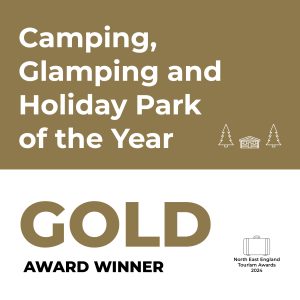- GPS Coordinates – N54.98620° / W2.42231°
We love everything about our Northumberland campsite and one of the best things we have here is the wildlife, particularly our feathered friends.
The campsite is alive with sound in the spring and summer but whatever the time of year, the birds are entertaining us with their tuneful songs and calls and it’s a joy to listen to and to watch them. They bring a smile to my face everyday and remind me of how lucky I am to be in this wonderful part of the country
Campers always enjoy the visitors to their tents or vans and we have a particularly special form of entertainment in the spring and summer when the swallows return to their nests right outside our reception door where we can watch the chicks grow and fledge. These must be the most photographed swallows in the country.
These are just some of the birds that you will easily see on the campsite but there are many more I’m sure
ONE SWALLOW DOES NOT A SPRING MAKE BUT LOTS OF SWALLOWS MAKE UP HADRIAN’S WALL CAMPSITE
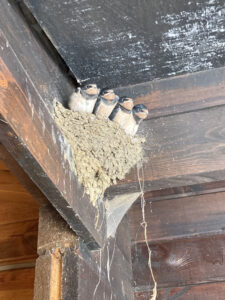 At our reception door, there are nests that you will recognise as the home of the swallow or more accurately the Hirundo Rustica! The nests are shaped like a cup, attached to the corners of the walls and are constructed with mud, grass and saliva. The inside is lined with more comfortable material such as feathers. This year we were lucky to watch these acrobatic birds rebuild one of their nests.
At our reception door, there are nests that you will recognise as the home of the swallow or more accurately the Hirundo Rustica! The nests are shaped like a cup, attached to the corners of the walls and are constructed with mud, grass and saliva. The inside is lined with more comfortable material such as feathers. This year we were lucky to watch these acrobatic birds rebuild one of their nests.
One had eroded and was unsafe so they built it up with remarkable speed. You might be able to see in the picture below the slight colour difference. It takes a great amount of effort to build a nest, apparently taking on average 1,300 trips to collect and carry the material to its destination.
So, no wonder most swallows will return to the same nest. This tendency to return to the nest is known as Philopatry.
BREEDING AT HADRIAN’S WALL CAMPSITE
We have 4 nests in total. 2 pairs of swallows will return and use 2 of the nests. They breed from May until July. Mum will incubate the eggs for 14 to 16 days. I feel like a proud parent when the first chicks appear after 2 weeks with their little beaks open in hopeful anticipation. As they grow and fatten up, they squash themselves in the nest, pushing each other to get their share of the food and bit by bit will sit on the edge of the nest. They fledge at 20 – 24 days but they do return to the nest at night. To see them fledge is both exciting and sad but just as I’m beginning to miss the daily show, they return again for the second brood. This time using the next 2 nests. What clever little things they are.
HOW DO YOU SPOT A SWALLOW?
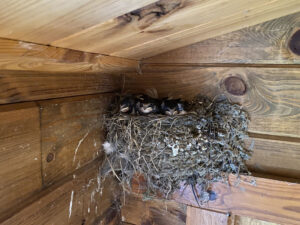 If you don’t know what a swallow looks like, you will certainly know them by the end of your stay with us. Their nests are surprisingly on show and close to our busy areas such as our reception/shop and our wash up sinks.
If you don’t know what a swallow looks like, you will certainly know them by the end of your stay with us. Their nests are surprisingly on show and close to our busy areas such as our reception/shop and our wash up sinks.
Washing up is certainly not as much of a chore at Hadrian’s wall campsite as you will be treated to a spectacle of a diving and swooping swallow and the chirping of little babes as they compete for their dinner.
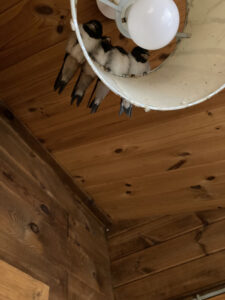 The swallow is dark blue almost black above and white below with a dark red or chestnut forehead and throat. It has a long, forked tail.
The swallow is dark blue almost black above and white below with a dark red or chestnut forehead and throat. It has a long, forked tail.
The adults will dive in and out quickly to the nests so their colouring isn’t easy to spot but you will see them sitting on the gutters and on our lampshade outside the shop door chirping happily and confidently. They will sometimes fly into the shop which can cause a few problems at times.
The swallow is a chatty little thing. It’s quite noisy with chirping almost like a fast clicking sound. Follow this link to hear what they sound like.
https://www.british-birdsongs.uk/barn-swallow/
WHAT DO THEY EAT?
Swallows feed on the wing. You’ll see them sweeping, diving and swooping in the fields and on our grass pitch areas. You’ll often see them on farmlands as they feast on the disturbed insects once the tractors have done their work. They will eat insects such as flies, beetles, moths and butterflies.
WHERE DO THEY GO IN THE WINTER?
The swallows are with us from April to October and when the food supplies dry up in the Autumn, they head south to make a 6000 mile journey through Europe to South Africa. Apparently, they travel 200 miles a day at around 20mph. What an incredible journey. It’s sad but not surprising to know that not all will survive the journey. The extreme weather conditions can be a problem for them and they can die of starvation or exhaustion. The female is particularly incredible as she will have flown all of those miles to get home and will be saving her fat reserves for forming her clutch of 4 or 5 eggs.
I’m so looking forward to welcoming them back again next year. We’re even lucky enough to have them nesting at our house and, along with our neighbours who also have their own brood, we have a great community of this wondrous little bird.
MAKE BEST FRIENDS WITH THE ROBIN (Erithacus rubecula)
We all know the robin with its brown colour above, white underneath and its famous red breast. Our favourite Christmas card subject. We associate this bird with our winter garden and I thought that was why it was our Christmas representative. However, in Victorian times, the postmen wore red waistcoats and were known as robin red breasts and it’s said that they were the inspiration for the robin Christmas card as they were the ones delivering the cards
Our robins do like to visit our guests and will often sit on someone’s foot, venture into their tent and join them for their dinner. Most don’t mind sharing with such a cute friend.
BREEDING
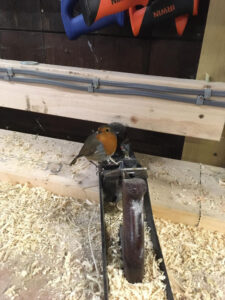 Unlike the swallow, we don’t get to see where the robin makes its nest. They will build their nests from dead leaves and moss and while they will usually nest near or on the ground in hedges or at tree roots for example, they are also renowned for nesting in all sorts of unusual places including plant pots and kettles or sheds. I wonder if our robin builds its nest in the big shed on our site which is home to so many birds, as I often get a little helper when I’m preparing the morning food for the ducks and Steve gets some help with his carpentry
Unlike the swallow, we don’t get to see where the robin makes its nest. They will build their nests from dead leaves and moss and while they will usually nest near or on the ground in hedges or at tree roots for example, they are also renowned for nesting in all sorts of unusual places including plant pots and kettles or sheds. I wonder if our robin builds its nest in the big shed on our site which is home to so many birds, as I often get a little helper when I’m preparing the morning food for the ducks and Steve gets some help with his carpentry
The female will incubate her eggs for 13 days and once they have hatched, she may eat some of the shells for extra calcium. The chicks will be fully feathered by 10 days and will fledge by day 14. Mum and dad will continue to care for the chicks for up to 3 weeks after they fledge although it tends to be dad that does the work as mum will be preparing the nest for the second brood. They can sometimes have 3 or 4 broods a year
A very lovely fact that I read while investigating our birdlife is that robins have great parental instincts and, while they are very territorial against other robins, they live quite happily with other birds and they have been known to feed chicks of other birds such as song thrush and black birds. That these birds are always seen and heard around our campsite might partly be due to the efforts of our lovely robins.
WHAT DO THEY EAT?
Robins have a varied diet of worms, seeds, fruits, insects and other invertebrates. They will often be around the gardener who is digging to take advantage of the worms. Our guests will often be able to feed them while they sit on their hands.
Robins on average only live a couple of years. Winter can have a big impact on their survival. They use around 10% of their body fat during a cold winter’s night and if they’re unable to replenish this during the day they can be in trouble. Some cheese, cake and biscuit crumbs along with some mealworms on a bird table will be a life saver in winter for this lovely little thing so if you’re here in Winter, you might want to leave a few cake crumbs
WHAT DO THEY SOUND LIKE?
The robin is one of the few birds that sing all year round and it’s fascinating that the Spring and Autumn songs are different with the spring song being much more confident and up beat. The male tends to be the loudest in spring as the purpose of its song is to defend its territory and to attract a mate.
Robins have good eyesight in poor light so they are often the first birds you will here in the dawn chorus and the last to sing at night
Click on this link to hear the robins beautiful song
https://www.british-birdsongs.uk/robin/
THE GREGARIOUS NOISY SPARROW (Passer Domesticus)
Our robins don’t really stand a chance when the sparrows are around. With their big numbers, they bully the robin out of the way if there’s food to be had. If you have any food in sight, the house sparrows will be there to make sure they get their fair share.
On the campsite, as well as socialising with the guests during mealtimes, you’ll see them around the duck pond in the small bushes there – our ducks, Beryl and Duke, also have to share their dinner!
There is also a large hedge where you’ll find the water tap and in the summer season this is where they will do their communal roosting and their social singing brings the hedge alive. If they’re disturbed by someone going past, the noise of their mini murmuration will echo around the site.
As they don’t keep very quiet, the sparrow hawk also knows they are there and at dawn you may see this bird of prey looking for its breakfast
A PLACE TO HANG OUT WITH THE BIRDS AT HADRIAN’S WALL
I could tell you about all of the birds that find their home at Hadrian’s wall campsite but it would be like writing a bird book as there are so many so I’ll just let you know about just some of the others that we love to watch and hear.
Sadly, we can’t tell you about our chickens that have happily roamed around our site as the fox visited last year. We won’t be replacing them just yet as we want to make sure any chickens we have at our site are able to play freely. The bird flu situation at the moment won’t allow that but hopefully we’ll enjoy the company of the hens once more soon. Watch this space
At the beginning of the busy season, Steve will wash the facilities building with his pressure washer and it looks fabulous with its new coat of wood stain.
I’ve told you about our lovely swallows who nest on the walls of the building, but we’re also the nursery for the starlings. They make their nests in the eaves of the building and you’ll know this, not just because you can watch them head into their place of safety with their beaks full of worms but because they make quite a mess on the walls of the building!
We would never try to clean it all while the birds are resident so we have to wait until we know they are definitely gone before getting the cleaning gloves on again.
The blackbirds take the prize for the most beautiful song I think and we’re often treated to this particularly around the shop area.
Have a listen here
https://www.british-birdsongs.uk/blackbird/
On a sunny day, if you get your coffee and breakfast at the café and sit outside, you will be treated to the most glorious song and dance musical theatre event. Beryl and Duke – our ducks – sometimes join in as the comedy act.
If you’re looking out for the song thrush, wagtail and blue tit, you won’t be disappointed at Hadrian’s wall campsite and at night when it’s totally peaceful, you’ll hear the hoot of the owl. I was totally treated recently when I was greeted by the tawny owl in our shed one night as I was locking up.
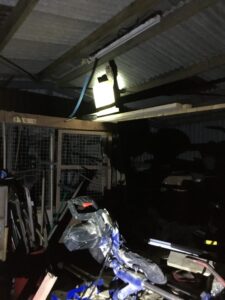 There will be many more of our avian friends around and we love to hear about different sitings from our customers. If you’re here, we’d love to know about others that I’ve not mentioned
There will be many more of our avian friends around and we love to hear about different sitings from our customers. If you’re here, we’d love to know about others that I’ve not mentioned
OUT AND ABOUT
Apart from on the campsite, the birdlife around the site is also incredible. When you walk out onto the fields opposite on a spring or summer’s day, or if you’re walking on Hadrian’s Wall, the air will be filled with the sound of the skylarks.
They are ground nesting birds and you’ll see them often when they impress with their rapid wing beats hovering over their territory for minutes before diving down again.
https://www.british-birdsongs.uk/sky-lark/?type713
and I can’t write about the birdlife around Hadrian’s wall without finally mentioning the Curlew – the national park’s logo.
Hopefully you’ll be treated to the sound of the curlew on your walks around Hadrian’s wall country but you may not be lucky enough to see them. They are the largest of the waders and a similar size to a sea gull but with longer legs and the typical long beak of a wader. We will hear it here in the Spring when it returns to the grassland to breed. In the Winter you may get to see it on the coast where it feeds in the sand and soft mud.
https://www.british-birdsongs.uk/curlew/?type1584
We are blessed to live here and I’m sure you’ll be amazed by the wildlife around so we’d love to see you here. Bring your bird book!

This is the perfect place for your Northumberland getaway. We have the most precious thing here, being surrounded by views and nature that make us smile every day.
All we want is for you to experience it also and we know you’ll love it as much as we do.
We want your holiday to be full of happiness and special memories – full of wellbeing- and we will always do our very best to ensure that happens.
A bit of nurture in nature.
